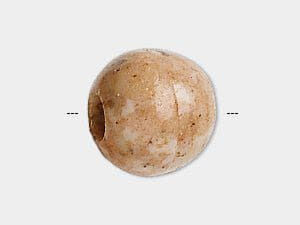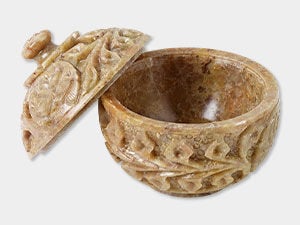Soapstone Meaning and Properties
Soapstone History
Soapstone, also called steatite and known by regional and marketing names, has been in use for thousands of years. It gets its name because of its softness and "soapy" feel. Soapstone is nonporous and nonabsorbent, which makes it a good material for kitchen countertops and sinks. It is also used for insulating electrical components due to its low electrical conductivity. Soapstone is also used for construction of fireplace surrounds and with metal woodstoves. In the art world, soapstone is used for inlaid designs and sculpture with some Native Americans using soapstone for traditional carvings. In the 19th century, soapstone was used for grave markers in Georgia and Ohio.
Soapstone Metaphysical Properties
Soapstone is commonly believed to have a soothing, balancing effect while creating a positive, calming energy. Soapstone is valued for it the way it helps one prepare for changes in life. It is also thought to promote truth, logic as well as rational and creative thinking. Soapstone’s physical benefits are said to be balancing the digestive system, reducing irritation and skin rashes, sun burns and allergies.
Soapstone Geological Properties
Soapstone is a metamorphic rock that is composed primarily of talc. It is formed most often in areas of Earth’s crust that are subjected to extreme heat and pressure. Because of its high talc content, soapstone is a relatively soft stone with a Mohs hardness of 1 which makes it easy to carve. It is nonporous, nonabsorbent and heat resistant.
- Mineral Information: Metaphoric rock, a variety of mineral species steatite
- Chemical Composition: Mg3Si4O10(OH)2
- Color: White, Gray, green, brown or light brown
- Hardness: 1 to 2-1/2 (Mohs)
- Specific Gravity: 2.75
- Refractive Index: 1.54
Proper Care of Soapstone
Soapstone is very soft with a Mohs hardness of 1, and should be treated with care. Clean soapstone with a soft dry cloth. Wash with warm, soapy water and a soft cloth or soft brush. Dry thoroughly. Do not apply harsh cleaning products that can include bleach and acid. Do not use ultrasonic cleaners or steamers.
Designing with Soapstone
While the color of natural soapstone tends toward lighter shades of gray, green or brown, soapstone can be coated to achieve brighter shades of those colors, making it ideal for autumn-themed jewelry.
Soapstone isn’t just for jewelry—it’s also cherished for its decorative and functional carved gifts. Handcrafted soapstone boxes, often adorned with intricate designs or animal motifs, make thoughtful keepsakes and unique gift ideas. Thanks to the stone’s softness, soapstone carving allows for exquisite detail and smooth finishes, making each piece a miniature work of art. Whether used to hold small treasures or simply admired for its craftsmanship, soapstone gifts bring warmth, tradition and natural beauty to any space.
Shop for Soapstone
**Please note that all metaphysical or healing properties listed are collected from various sources. This information is offered as a service and not meant to treat medical conditions. Fire Mountain Gems and Beads® does not guarantee the validity of any of these statements.
How did you like this resource? Your feedback helps us provide resources that matter to you most.
Copyright Permissions
All works of authorship (articles, videos, tutorials and other creative works) are from the Fire Mountain Gems and Beads® Collection, and permission to copy is granted for non-commercial educational purposes only. All other reproduction requires written permission. For more information, please email copyrightpermission@firemtn.com.


